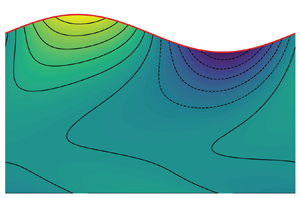No CrossRef data available.
Article contents
Linear stability analysis of a vertical liquid film over a moving substrate
Published online by Cambridge University Press: 27 November 2024
Abstract

The stability of liquid-film flows is essential in many industrial applications. In the dip-coating process, a liquid film forms over a substrate extracted at a constant speed from a bath. We studied the linear stability of this film considering different thicknesses  $\hat {h}$ for four liquids, spanning an extensive range of Kapitza numbers (
$\hat {h}$ for four liquids, spanning an extensive range of Kapitza numbers ( $Ka$). By solving the Orr–Sommerfeld eigenvalue problem with the Chebyshev–Tau spectral method, we calculated the threshold between growing and decaying perturbations, investigated the instability mechanism, and computed the absolute/convective threshold. The instability mechanism was studied by analysing the perturbations’ vorticity distribution and the kinetic energy balance. It was found that liquids with low
$Ka$). By solving the Orr–Sommerfeld eigenvalue problem with the Chebyshev–Tau spectral method, we calculated the threshold between growing and decaying perturbations, investigated the instability mechanism, and computed the absolute/convective threshold. The instability mechanism was studied by analysing the perturbations’ vorticity distribution and the kinetic energy balance. It was found that liquids with low  $Ka$ (e.g. corn oil,
$Ka$ (e.g. corn oil,  $Ka = 4$) are stable for a smaller range of wavenumbers compared with liquid with high
$Ka = 4$) are stable for a smaller range of wavenumbers compared with liquid with high  $Ka$ (e.g. liquid zinc,
$Ka$ (e.g. liquid zinc,  $Ka = 11\,525$). Surface tension has a stabilising and a destabilising effect. For long waves, it curves the vorticity lines near the substrate, reducing the flow under the crests. For short waves, it fosters vorticity production at the interface and creates a region of intense vorticity near the substrate. In addition, we discovered that the surface tension contributes to both the production and dissipation of perturbation's energy depending on the
$Ka = 11\,525$). Surface tension has a stabilising and a destabilising effect. For long waves, it curves the vorticity lines near the substrate, reducing the flow under the crests. For short waves, it fosters vorticity production at the interface and creates a region of intense vorticity near the substrate. In addition, we discovered that the surface tension contributes to both the production and dissipation of perturbation's energy depending on the  $Ka$ number. Regarding the absolute/convective threshold, we identified a window in the parameter space where unstable waves propagate throughout the entire domain (indicating absolute instability). Perturbations affecting Derjaguin's solution (
$Ka$ number. Regarding the absolute/convective threshold, we identified a window in the parameter space where unstable waves propagate throughout the entire domain (indicating absolute instability). Perturbations affecting Derjaguin's solution ( $\hat {h}=1$) for
$\hat {h}=1$) for  $Ka<17$ and the Landau–Levich–Derjaguin solution (
$Ka<17$ and the Landau–Levich–Derjaguin solution ( $\hat {h}=0.945 Re^{1/9}Ka^{-1/6}$), are advected by the flow (indicating convective instability).
$\hat {h}=0.945 Re^{1/9}Ka^{-1/6}$), are advected by the flow (indicating convective instability).
Information
- Type
- JFM Papers
- Information
- Copyright
- © The Author(s), 2024. Published by Cambridge University Press


